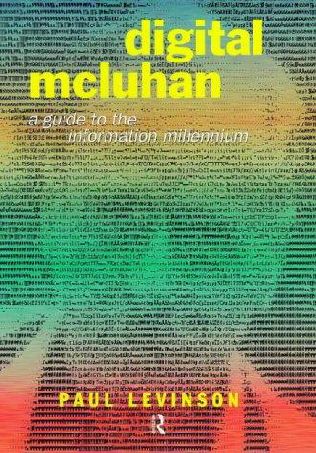Marshall McLuhan: Understanding Media: The Extensions of Man (1964–) [EN, SC, CZ, DE, CR]
Filed under book | Tags: · advertising, film, global village, history of technology, mass media, media technology, media theory, money, new media, phonograph, photography, print, radio, technology, telegraphy, telephone, television

“When first published, Marshall McLuhan’s Understanding Media made history with its radical view of the effects of electronic communications upon man and life in the twentieth century. In Terrence Gordon’s own words, “McLuhan is in full flight already in the introduction, challenging us to plunge with him into what he calls ‘the creative process of knowing.'” Much to the chagrin of his contemporary critics McLuhan’s preference was for a prose style that explored rather than explained. Probes, or aphorisms, were an indispensable tool with which he sought to prompt and prod the reader into an “understanding of how media operates” and to provoke reflection.
In the 1960s McLuhan’s theories aroused both wrath and admiration. It is intriguing to speculate what he might have to say 40 years later on subjects to which he devoted whole chapters such as Television, The Telephone, Weapons, Housing and Money. Today few would dispute that mass media have indeed decentralized modern living and turned the world into a global village.”
First published in 1964
With a new introduction by Lewis H. Lapham
Publisher The MIT Press, 1994
ISBN: 0262631598, 9780262631594
392 pages
Understanding Media: The Extensions of Man (English, 1964/1994, updated on 2019-2-27)
Poznavanje opštila: čovekovih produžetaka (Serbo-Croatian, trans. Slobodan Đorđević, 1971, added on 2015-12-21)
Jak rozumět médiím: Extenze člověka (Czech, trans. Miloš Calda, 1991, added on 2014-3-13)
Die magischen Kanäle: Understanding Media (German, trans. Meinrad Amann, 1992, added on 2013-11-22)
Razumijevanje medija (Croatian, trans. David Prpa, 2008, added on 2013-11-22)
Paul Levinson: Digital McLuhan: A Guide to the Information Millennium (1999)
Filed under book | Tags: · computing, global village, internet, mass media, media, media theory

“Marshall McLuhan died on the last day of 1980, on the doorstep of the personal computer revolution. Yet McLuhan’s ideas, developed in the 1950s, ’60s and ’70s, presaged a world of media in motion, and its impact on our lives on the dawn of the new millennium. McLuhan’s phrase, “the medium is the message” is his best known and most misunderstood concept. Paul Levinson presents the accuracy of McLuhan’s thinking unavailable while he was alive, and shows him as a man struggling to communicate in an electronic pattern via the straightjacket of paper. Levinson also examines why McLuhan’s theories about media are more important to us today than when they were first written, and why the Wired generation is now turning to McLuhan’s work to understand the global village in the digital age. By exploring the technological influence in industries from publishing to politics, entertainment to business, McLuhan opened the doors for understanding the human relationship with technology. Levinson’s own exploration of McLuhan’s significance in the new electronic generation clarifies the prophetic insights, principles and constructs in McLuhan’s work.”
Publisher Routledge, 1999
ISBN 041519251X, 9780415192514
226 pages
Keywords and phrases: personal computer, theremin, rear-view mirror, Marshall McLuhan, tetrad, Connected Education, Neil Postman, RealAudio, mass media, CP/M, Communications Decency Act, global village, Media Ecology, Internet, Gutenberg Galaxy, Paul Levinson, voyeurs, Eric McLuhan, Kaypro, RealVideo.
PDF (updated on 2022-11-12)
Comments (4)Niklas Luhmann: The Reality of the Mass Media (1995/2000)
Filed under book | Tags: · autopoiesis, communication, cybernetics, information, mass media, media theory, recursion, social science, systems theory, theory of communication

“In The Reality of the Mass Media, Luhmann extends his theory of social systems — applied in his earlier works to the economy, the political system, art, religion, the sciences, and law — to an examination of the role of mass media in the construction of social reality.
Luhmann argues that the system of mass media is a set of recursive, self-referential programs of communication, whose functions are not determined by the external values of truthfulness, objectivity, or knowledge, nor by specific social interests or political directives. Rather, he contends that the system of mass media is regulated by the internal code information/noninformation, which enables the system to select its information (news) from its own environment and to communicate this information in accordance with its own reflexive criteria.
Despite its self-referential quality, Luhmann describes the mass media as one of the key cognitive systems of modern society, by means of which society constructs the illusion of its own reality. The reality of mass media, he argues, allows societies to process information without destabilizing social roles or overburdening social actors. It forms a broad reservoir (memory) of options for the future coordination of action, and it provides parameters for the stabilization of political reproduction of society, as it produces a continuous self-description of the world around which modern society can orient itself.
In his discussion of mass media, Luhmann elaborates a theory of communication in which communication is seen not as the act of a particular consciousness, nor the medium of integrative social norms, but merely the technical codes through which systemic operations arrange and perpetuate themselves.”
First published as Die Realität der Massenmedien, Westdeutscher Verlag, 1995.
Translated by Kathleen Cross
Published by Stanford University Press, 2000
ISBN 0804740771, 9780804740777
154 pages
Key terms: mass media, second-order cybernetics, autopoiesis, Heinz von Foerster, autopoietic, Laws of Form, Elisabeth Noelle-Neumann, constructivist epistemology, Gregory Bateson, recursive, Spencer Brown, Katherine Hayles, Michel Serres, Baltasar Gracian, Amos Tversky, Hans Ulrich Gumbrecht, munication, Ludwig Tieck
PDF (updated on 2012-7-17)
Comment (0)
